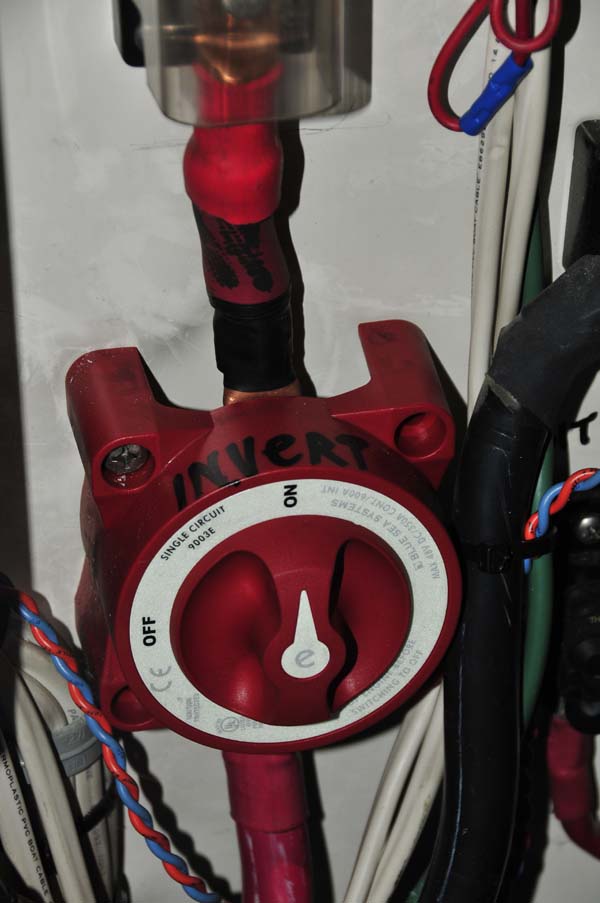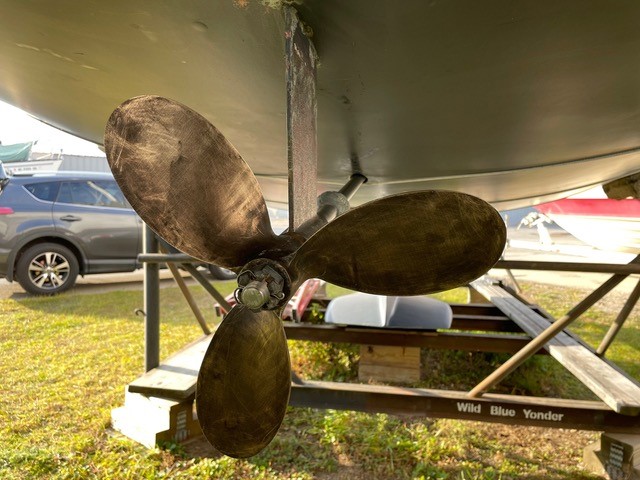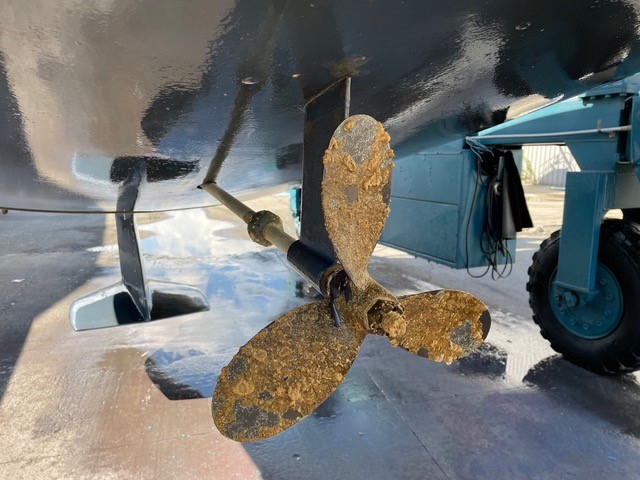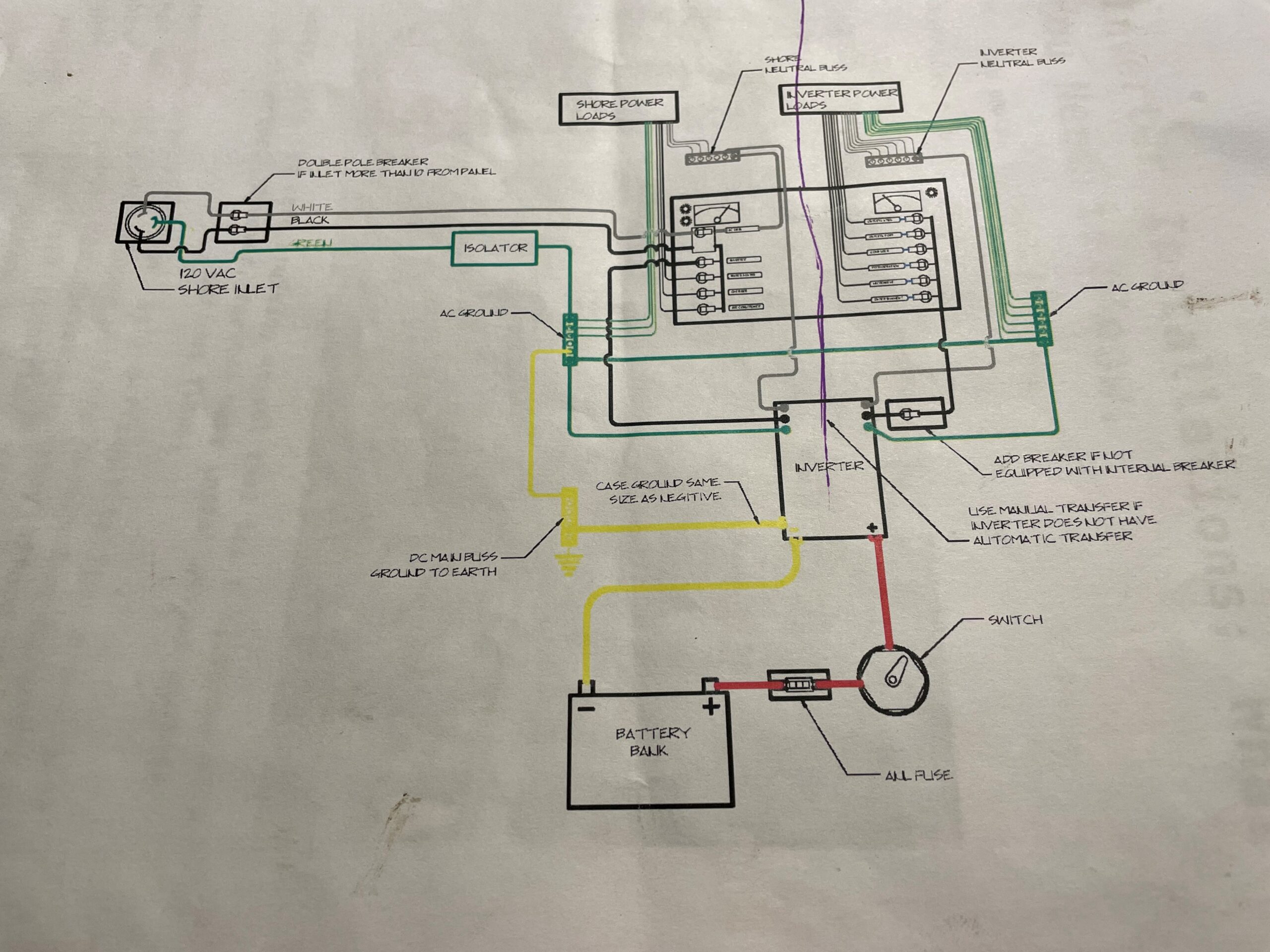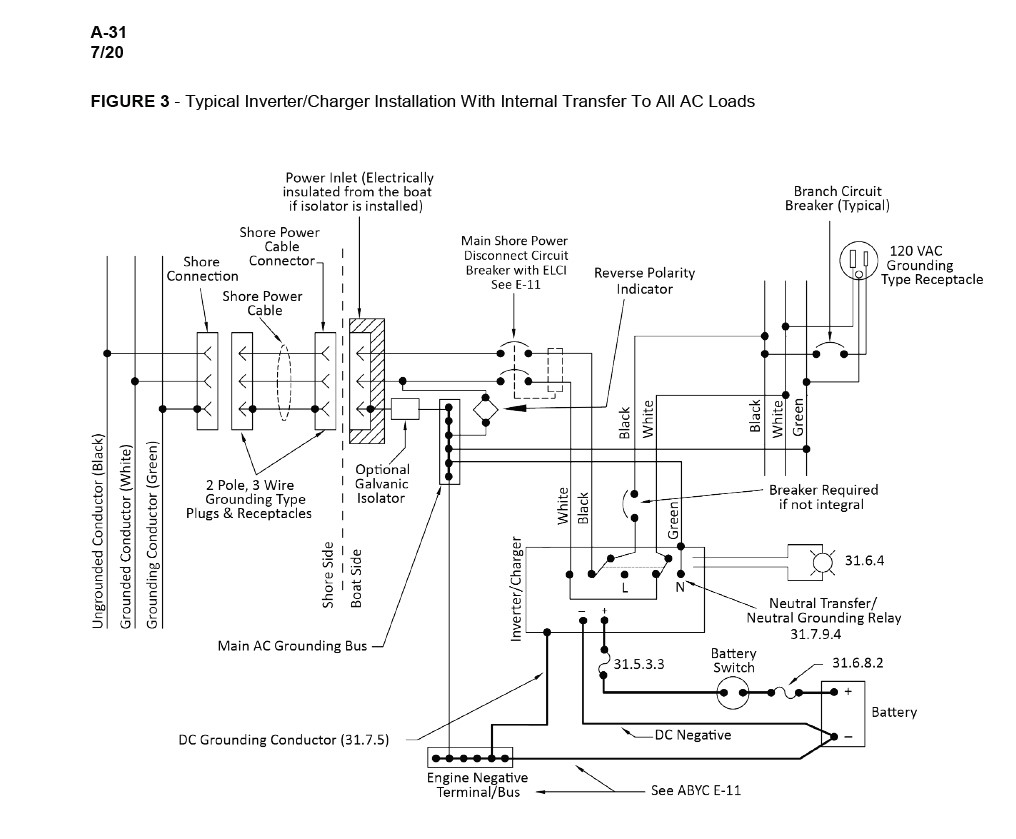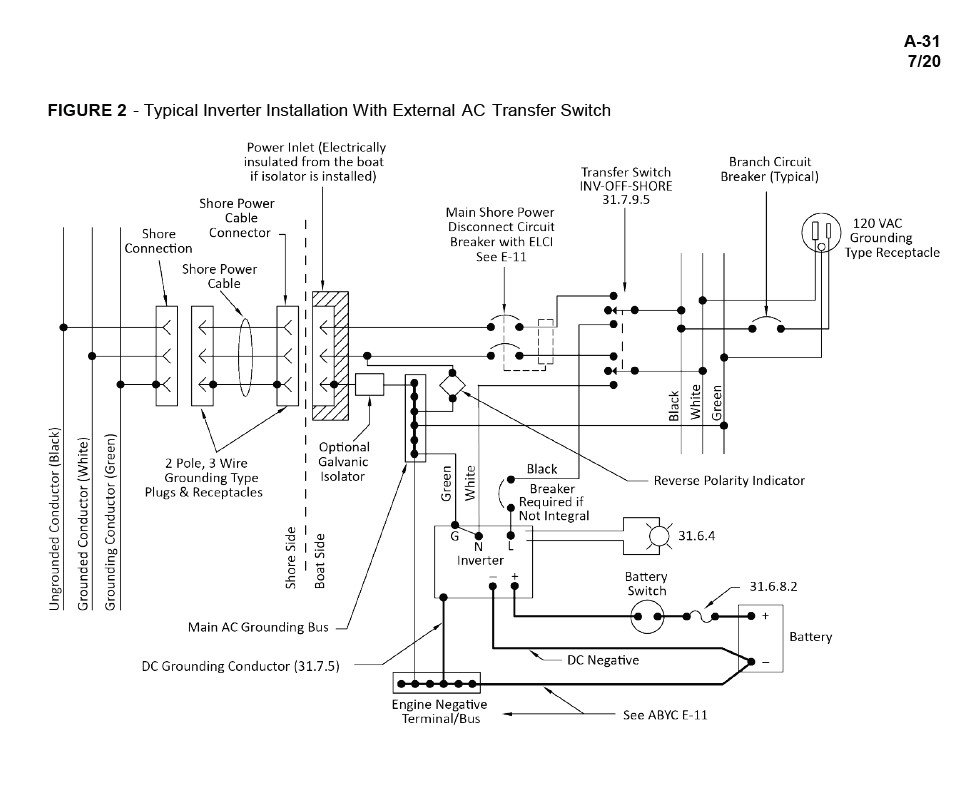Photo Essay: Inverter Disconnect
I clearly recall installing my first modified/square sign wave inverter back in the early 90s, it seemed miraculous that boat owners could now use AC appliances, albeit small ones, like coffee makers, TVs, and VCRs, without the need for a generator. Those inverters were usually in the 1,000-1,500-Watt range, small by today’s standards, and some items, like printers and bread makers in particular, didn’t like the modified sign wave. Fast forward 30-years and stacked, true sign wave inverter systems, capable of running virtually everything aboard, supplying 16 kW and more, are not uncommon.
While inverters have become commonplace, they are not without risk. Because the DC current supplied to most inverters is especially high, cable sizing, and termination, technique must be flawless. Additionally, inverters can supply lethal AC current, capable of electrocution. Insidiously, inverters that are dormant, because there is no load, may show zero volts when tested with a multimeter, however, if a person touches the “hot” conductor, it can present enough resistance to “wake-up” the inverter, giving him or her a nasty shock, or worse (this happened to me just a few days after writing a draft of this column, while inspecting a vessel under construction). It is, therefore, imperative that those working on the AC systems of inverter-equipped vessels, be aware of the inverter’s presence (the main AC electrical panel must include a warning indicating an inverter is part of the system), and that they safely disable it before beginning any AC electrical work. The only reliable method of rendering an inverter safe is to disconnect it from its DC power source; simply turning off the inverter from a control panel is not considered adequate.
The accompanying image depicts an inverter disconnect switch, a feature that should be included with every inverter installation. The switch enables the inverter to be de-energized quickly and easily, for both service work, as well in the event of an electrical fire.
Ask Steve
Hi Steve,
We see some minor leaks on port Nordhavn 47 fuel tanks (into an area behind side storage access panel) and starboard (sight glass), and have checked the sight glasses and they are not leaking in their external piping.
We have discussed with the yard to search inside of the main tanks for a leak, and maybe re-bedding the sight glasses, and clean the tank while inside. The tank is fiberglass.
If there is a repair to be made, and all the inside surfaces are covered with diesel and residue, what material can be used in this diesel contaminated environment in order to make a repair that will not leak?
1) If some fiberglass work needs to be done?
2) If we are re-bedding metal tubes penetrating the glass, feeding the site glasses?
Thank you,
Eric Kutscha
Eric:
Fittings installed on most modern Nordhavn tanks use a clamp arrangement (it’s the preferred approach), i.e. like a thru-hull fitting, so it does not rely on a bond between FRP (fiberglass reinforced plastic, trade slang for fiberglass) and metal fitting, glassing metallic fittings into tanks almost never works. Let me know what you find. I have had the gaskets leak between clamp and tank, and those can be replaced.
I’d want to be 100% sure of the leak source, and I’d do that by thoroughly cleaning the area using brake cleaner and then carefully watching for the leak source. Also, pressurizing the (empty) tank to no more than 3 psi and then spraying the area with soapy water will help identify the leak source.
If fiberglass that has been exposed to fuel needs to be repaired, it must, must, must be ground, no amount of cleaning will work, and even if fuel was not a contaminant issue, FRP always needs to be ground to carry out re-lamination/repair. Any FRP repair is a secondary bond, more on those here.
If you need to re-bed the clamp plates/tubes or thru-tank fittings (different application than a thread sealant), a fuel-resistant bedding compound must be used, I prefer polysulfide, here’s an example. For sealing pipe threads I use Leak Lock.
This article, as well as this article, were recently published in Professional BoatBuilder. You and the yard, if they have not seen them, may find them helpful.
Hi Steve,
I recently read your article published in Cruising World Magazine where you touched on cathodic disbondment as a result of over protection from anodes. I thought you might be able to help me out on a conundrum I’m trying to solve before next sailing season.
Some information on the boat; I sail a Catalina 320 out of Menominee Marina on Green Bay, Lake Michigan so obviously fresh water. The boat has a stainless shaft, bronze strut and prop (Michigan Sailor), and copper based VC17 bottom paint on the fiberglass hull. When I first purchased the boat five years ago, I put a zinc anode on shaft not knowing that magnesium is required in fresh water. That anode was on the shaft for all of the previous five seasons. Since 2020 I have run a Dairyland Electric Industries failsafe galvanic isolator on the shore power, and it tested fine this fall, when the boat was in the cradle.
This past October, we hauled the boat for the season, and there was a hard thick coating mostly on the bronze prop, but also heavy on the stainless shaft tip and some on the zinc anode and bronze strut. My first reaction was, “Oh crap I just cooked a thousand-dollar prop with galvanic corrosion” but after an aggressive power washing and scraping with a metal putty knife, I found there was no pitting or metal lost to be found. In fact, the threads on the stainless shaft were untouched and even the cotter pin was 100% intact as you can see on the second attached photo after cleaning. The drivetrain was clean as a whistle when the boat was splashed in May of 2022, so the first attached photo shows one season’s worth of buildup. What’s strange is that nothing was really changed on the boat since the new isolator installation in 2020 and there was no buildup or anything odd in any previous season. I talked with the two boatyards that service our marina and even stranger is that out of all the boats, a couple of hundred that slip in Menominee, I was the only one with this odd coating.
My electrical understanding is pretty rudimentary, but it doesn’t seem that I’d be over protected and have a cell issue taking place since my anode was zinc (in fresh water), and although the coating favored the prop, it was also distributed across the stainless shaft and zinc itself. With this much build up, my guess is that there’s some sort cathodic issue taking place and I’m pushing a positive current into the water, as you would on a pipeline using cathodic protection. I’m not sure if this could be the case, whether the isolator would block this from happening on the shore power, or where I should start looking to diagnose this problem. Any ideas on what’s taking place here and course of action would be greatly appreciated. I obviously want to get it troubleshot before the summer season.
Thanks for your help,
Michael Leschisin
Michael:
Without some level of testing, it’s difficult for me to speculate on the cause behind the buildup, however, it appears to be calcareous in nature. Calcareous coatings are often found on zinc anodes when used in fresh water, however, I have never seen that extend to the metals they are ostensibly protecting.
My recommendation would be to replace the zinc with an aluminum anode, and then after launching the vessel carry out a reference cell test, to confirm you are neither over nor under-protected. I would also install an ABYC compliant galvanic isolator if not already present. You didn’t mention if the vessel is bonded, however, if not, then each underwater metal, including the shaft must be tested. Either way, because the shaft is essentially isolated via an oil-filled transmission, its protection level should be tested.
For more on reference cell testing see this article.
Steve,
I read your article on inverter installations and have a question.
My inverter is in a houseboat, and I’m just wanting to make sure where the chassis ground goes. I have a bank of house batteries that the inverter uses and charges, completely separate from the engines. Everything I can find says the inverter chassis ground goes to the AC earth ground.
Looking for clarification.
Thank you,
Rocky Paratore
Ross:
The following diagrams (there are four, however, these two are relevant to your scenario), and associated text, from ABYC chapter A-31, Battery Chargers and Inverters, clearly depicts/describes the requirements for the DC Grounding and AC safety grounding conductors.
These two grounding conductors, AC and DC, are critically important, as they will carry both AC and DC fault current back to its source, thereby clearing the fault by tripping the circuit breaker or fuse respectively.
I strongly recommend, upon completion of your installation, but before powering it up, you have it reviewed by an ABYC Certified electrician; you can find them geographically by visiting this site.
ABYC A-31.7.5 DC Grounding Connections
31.7.5.1 The DC grounding conductor (see FIGURE 1, FIGURE 2, FIGURE 3, and FIGURE 4) shall:
31.7.5.1.1 be connected from the metallic case or chassis to the engine negative terminal or its bus, and
31.7.5.1.2 shall be of an ampacity equal to that of the DC positive conductor.
EXCEPTION: The DC grounding conductor may be one size smaller than the minimum size conductor required for the DC current-carrying conductors (see ABYC E-11, AC and DC Electrical Systems on Boats, “Allowable Amperage of Conductors For Systems Under 60 Volts”) providing the overcurrent protection device in the DC positive conductor is rated no greater than 135% of the ampacity of the DC grounding conductor and the conductor is no smaller than 16 AWG.
NOTE: The DC grounding conductor is not necessary if the case is made of plastic or nonconductive material and the case completely isolates the DC conductors from any grounded metallic internal parts, and there are no grounded metal parts the ungrounded DC terminal could contact.

